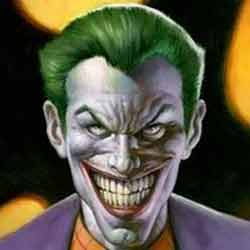The Joker is a supervillain and the archenemy of Batman. He was first introduced in Batman #1 (Spring 1940) and has remained consistently popular. The Joker is a master criminal with a clown-like appearance. Initially portrayed as a violent sociopath who murders people for his own amusement, the Joker later in the 1940s began to be written as a goofy trickster-thief. That characterization continued through the late-1950s and 1960s before the character became again depicted as a vicious, calculating, psychopathic killer. The Joker has been responsible for numerous tragedies in Batman's life, including the paralysis of Barbara Gordon (Batgirl/Oracle) and the murders of Jason Todd (the second Robin) and Jim Gordon's second wife Sarah Essen.
Interpretations of the Joker in other media include Cesar Romero's in the 1960s Batman television series, Jack Nicholson's in Tim Burton's Batman, and Mark Hamill's in Batman: The Animated Series and other DC Animated Universe shows. Wizard magazine listed him the #1 villian of all time in 2006. As played by Nicholson, The Joker ranks #45 in the American Film Institute's list of the top 50 film villains of all time. Heath Ledger signed to play the Joker in July 2006, for director Christopher Nolan's Batman Begins sequel, The Dark Knight and won a posthumous Oscar for his performance. He was also achieved the rank of the 8th Greatest Comic Book Character of All Time list, which was released by Empire (notably being the highest ranked villain character on the list), as well as being the fifth Greatest Comic Book Character Ever in Wizard Magazine's 200 Greatest Comic Book Characters of all Time list, once again being the highest ranked villain on the list.
Originally conceived as an evil "court-jester" type, the character was initially rejected by studio writer Bill Finger as being "too clownish," but he later relayed the idea to Bob Kane. Kane, who started out as a gag artist, loved the concept and encouraged its production. Finger found a photograph of actor Conrad Veidt wearing make-up for the silent film The Man Who Laughs, and it was from this photograph that the Joker was modeled. This influence was referenced in the graphic novel Batman: The Man Who Laughs, a retelling of the first Joker story from 1940.
In his initial dozen or so appearances, starting with Batman #1 (1940), the Joker was a straightforward spree killer/mass murderer, with a bizarre appearance modeled after the symbol of the Joker known from playing cards. It is of note that in his second appearance he was actually slated to be killed off, with the final page detailing the villain accidentally stabbing himself, lying dead as Batman and Robin run off into the night. DC editor Whitney Ellsworth thought the Joker was too good a character to kill off, suggesting that he be spared. A hastily drawn panel, calculated to imply that the Joker was still alive, was subsequently added to the comic.















